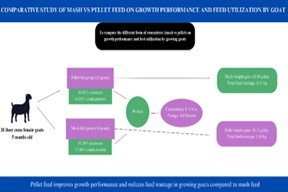Comparative study of mash vs pellet feed on growth performance and feed utilization by goat
Abstract
This study was conducted in Bharatpur-11, Chitwan, Nepal, to evaluate the effects of two feed forms (mash and pellet) on the growth performance and feed utilization in goats. Twenty Boer cross female goats, averaging five months in age, were assigned to either mash or pellet feed treatments, with 10 goats in each group, for a 90-day period, with two weeks of adaptation. The experimental animals were given concentrate feed at 1% of their body weight daily, along with ad libitum access to Napier grass and clean drinking water. Both feed types had a dry matter content of 90% and a crude protein level of 17%. Key parameters assessed included feed and forage intake, body weight changes, and feed wastage. Goats on pelleted feed showed a significantly higher average daily weight gain of 62.00 g/day compared to 26.11 g/day for those on mash feed. Final body weights were also greater in the pellet-fed group (28.88 kg) compared to the mash-fed group (25.04 kg). Additionally, pelleted feed led to higher intake of concentrate and forages and significantly reduced feed wastage, with pellet feed waste being 1.22 g/day versus 27.65 g/day for mash feed. These findings indicate that pelleted feed enhances growth performance, feed intake, and feed efficiency in goats. Therefore, this study indicated that pelleted feed is a more effective option for enhancing goat productivity and reducing feed wastage.
Keywords:
Body weight, Feed utilization, Goat, Mash, PelletDownloads
References
Ahmed, S., Rakib, M. R. H., Hemayet, M. A., Roy, B. K., & Jahan, N. (2020). Effect of complete pellet feed on commercial goat production under the stall feeding system in Bangladesh. Journal of Advanced Veterinary and Animal Research, 7(4), 704-709.
Department of Livestock Services (DLS). (2022). Annual report 2020/21. Government of Nepal
Malik, M. I., Rashid, M. A., Yousaf, M. S., Naveed, S., Javed, K., Nauman, K. (2021). Rumen morphometry and sorting behavior of fattening male goat fed pelleted and unpelleted TMR with two levels of wheat straw. Small Ruminant Research, 196, 106316. https://doi.org/10.1016/j.smallrumres.2021.106316
O'Meara, F. M., Gardiner, G. E., O'Doherty, J. V., & Lawlor, P. G. (2020). The effect of feed form and delivery method on feed microbiology and growth performance in grow-finisher pigs. Journal of Animal Science, 98(3), skaa021. https://doi.org/10.1093/jas/skaa021
Rashid, M. A., Khan, M. J., Khandoker, M. A. M. Y., & Monir, M. M. (2016). Feeding different forms of ration including compound pellet and performance of growing black Bengal goat. Journal of Agriculture and Veterinary Science, 9(5), 1-8.
Singh, S. B., & Singh, N. (2019). Nepal livestock feed balance and strategies to address the feed deficit. Journal of Agriculture and Forestry University, 3, 159-171.
Zhang, C., Li, M. M., Al-Marashdeh, O., Gan, L. P., Zhang, C. Y., & Zhang, G. G. (2019). Performance, rumen fermentation, and gastrointestinal microflora of lambs fed pelleted or unpelleted total mixed ration. Animal Feed Science and Technology, 253, 22-31. https://doi.org/10.1016/j.anifeedsci.2019.05.003

Published
How to Cite
Issue
Section
Copyright (c) 2024 Agriculture and Environmental Science Academy

This work is licensed under a Creative Commons Attribution-NonCommercial 4.0 International License.

